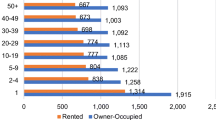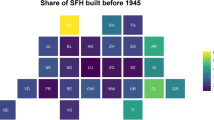Abstract
This paper presents two important analyses, which have been derived from a rich dataset supplied by an important Property & Casualty Carrier in the Canadian Market (here we can introduce a footnote suggesting that due to the anonymity requirement we will abbreviate this important Property & Casualty Carrier in the Canadian Market as PCC). These analyses provide us with an improved understanding of house values, via a detailed analysis of their predicted reconstruction costs. In an initial step, we propose a new model that focuses on the modeling of house reconstruction cost (HRC) using 16 predictors, which include the materials and composition of the buildings. In a second step, we analyze the distribution of HRC using quantile regressions, in order to gain a better understanding of the influence of HRC skewness, which is driven by the most expensive houses. It is found that when a broad set of (16) predictors is used, the “Living Space” alone accounts for 54.87% of the cost variation, while the square of this variable accounts for another 9.4% of the variation in cost. Quantile analysis provides additional information, as the impact of certain coefficients on the cost of less expensive houses is different to that of expensive houses. In particular, the “Age of Construction” coefficient at the 25th quantile is 3 times higher (in absolute value) than at the 99th quantile, whereas the quantiles estimates for the nonlinear influence increase with quantile value, suggesting a move towards an exponential influence of age on the reconstruction cost of expensive houses. The “Living Space” predictor reveals that the living-space cost is approximately 4 times greater at the 25th than at the 95th quantile, whereas the nonlinear influence of living space varies from a negative effect (lower quantiles) to a positive effect (upper quantiles), suggesting that the cost curve changes from concave at lower quantiles to convex at higher quantiles.







Similar content being viewed by others
Notes
If no renovations were carried out, the age is taken to be that of the construction.
We were unable to include “Number of bathrooms” and “Has porch or deck” (used by Ottensmann), as this information was not available in our database.
References
Adair A., S. McGreal, A. Smyth, J. Cooper and T. Ryley, (2000). House prices and accessibility: the testing of relationships within the Belfast Urban Area. Housing Studies, 15(5).
Bowen, W. M., Mikelbank, B. A., & Prestegaard, D. M. (2001). Theoretical and empirical considerations regarding space in hedonic housing price model applications. Growth and Change, 32(4), 466–490.
Hansen, J. (2009). Australian House Prices: A Comparison of Hedonic and Repeat-Sales Measures. The Economic Record, 85(269), 132–145.
Jones, C., Leishman, C., & MacDonald, C. (2009). Sustainable urban form and residential development viability. Environment and Planning A, 41(7), 1667–1690.
Jones, C., Coombes, M., Dunse, N., Watkins, D., & Wymer, C. (2012). Tiered Housing Markets and their Relationship to Labour Market Areas. Urban Studies, 49(12), 2633–2650.
Kain, J. F., & Quigley, J. M. (1970). Measuring the value of house quality. Journal of the American Statistic-al Association, 65(330), 532–548.
Monson, M. (2009). Valuation Using Hedonic Pricing Models. Cornell Real Estate Review, 7(1), 62–73.
Ottensmann J. R., S. Payton, and J. Man, (2008). Urban location and housing prices within a hedonic model. The Journal of Regional Analysis & Policy, 38(1).
Acknowledgements
The Authors wish to thank MITACS and an important Property & Casualty Carrier in the Canadian Market for their grant support IT05985. All errors are the responsibility of the authors. We also thank Glenn Lund for many valuable discussions, helpful comments and his own contribution to this study.
Author information
Authors and Affiliations
Corresponding author
Ethics declarations
Conflict of Interest
The authors declare that they have no conflict of interest.
Appendix
Appendix
Specification test
It is possible to test for the absence of important variables through the use of an omitted-variable test. The link test provided by Stata is based on the idea that if a regression or regression-like equation is correctly specified, there can be no additional significant independent variables, except by chance. One kind of specification error is called a link error. In regression, this means that the dependent variable needs a transformation or “link” function to properly relate to the independent variables. The idea of a link test is to add an independent variable to the equation, which is very likely to be significant if there is a link error.
(Let) y = f(Xβ)be the model and \( \widehat{\beta} \) be the parameter estimates. The link test calculates.
hat = \( X\widehat{\beta} \) (prediction) and hatsq = hat2.
The model is then refitted with these two variables, and the test is based on the significance of hatsq, in which hat is the house reconstruction cost prediction. The significance of hatsq’s coefficient confirms the rejection of the null hypothesis, which means that the proposed model has omitted variables. The above is the form developed by Pregibon (1979), based on a method proposed by Tukey (1949).
The result of the link test on our model is as follows:
From the above results, the p-value of the variable hat’s coefficient is equal to 0.001, implying that our model yields a significant prediction of house reconstruction cost. On the other hand, the significance of the variable hatsq’s coefficient means that there are omitted variables in the model. This also confirms 75.9% of the value of R-squared, shown in the last line of the 5th column in Table 5, which means that 75.9% of the variance of the dependent variable is predicted by the independent variable.
Heteroscedasticity test
Rights and permissions
About this article
Cite this article
Voia, MC., Doan, T.H.T. What We Should Know About House Reconstruction Costs?. J Real Estate Finan Econ 58, 489–516 (2019). https://doi.org/10.1007/s11146-017-9642-z
Published:
Issue Date:
DOI: https://doi.org/10.1007/s11146-017-9642-z




